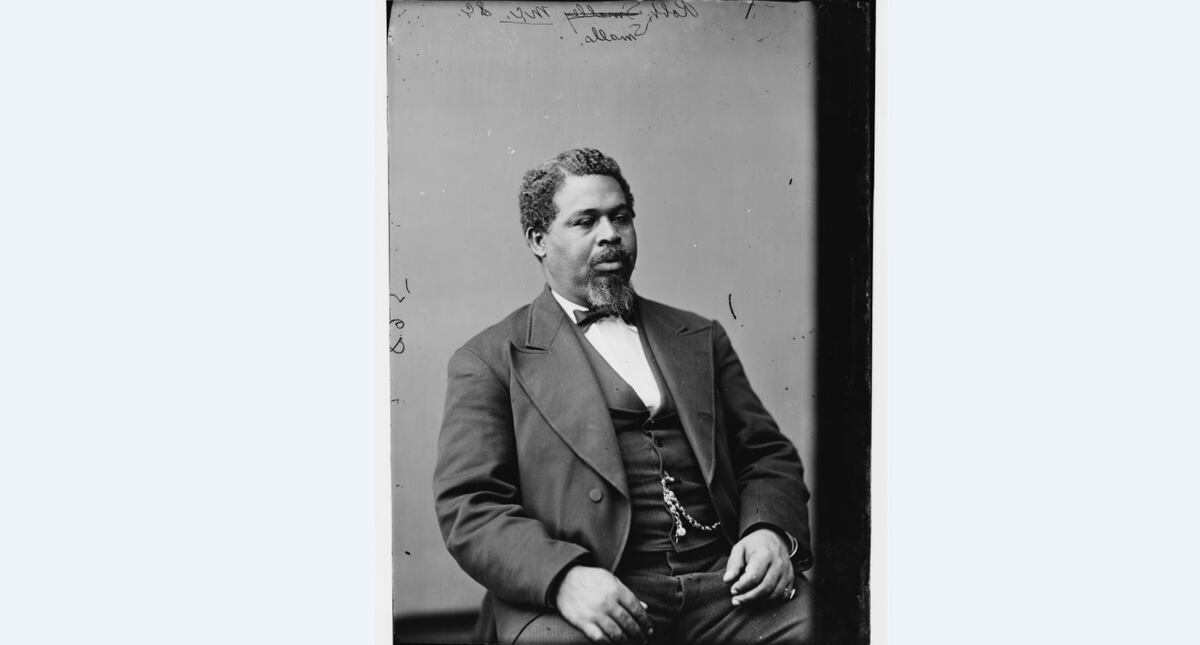This story begins in Charleston, South Carolina, on May 12,1862.
A wood-burning, steam-powered vessel with a crew of black men, flying the flags of South Carolina and the Confederacy, set out from a dock, headed toward the Union blockading fleet.
The journey would forever alter one man’s life and the course of his country.
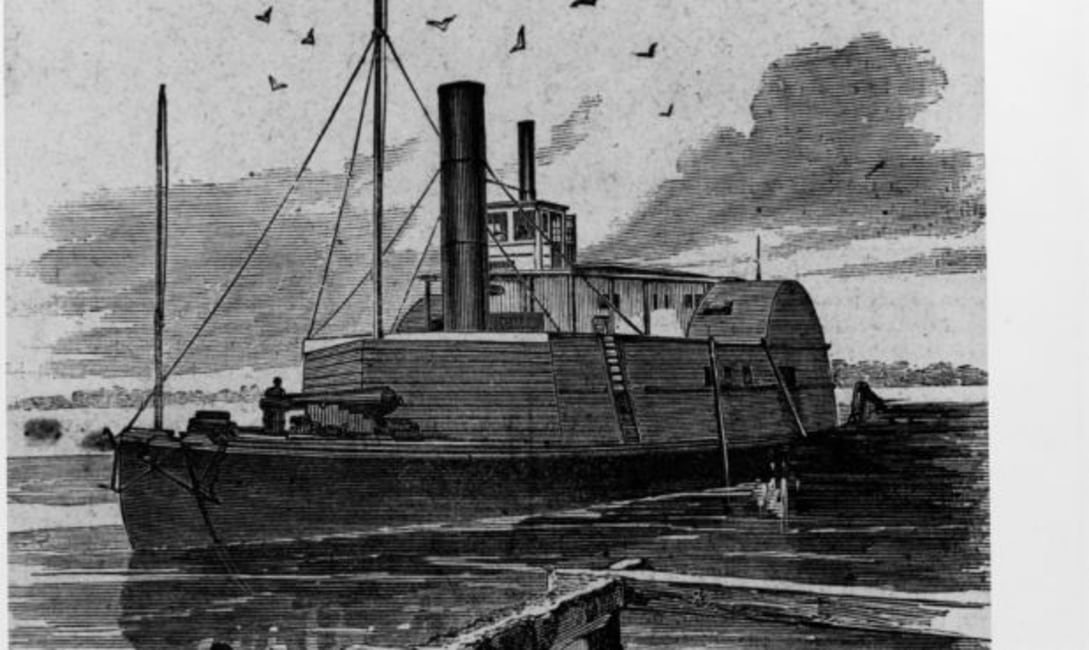
Robert Smalls, captain of that ship, came into the world a slave on April 5, 1839, in Beaufort, South Carolina, a little town located on Port Royal, one of the many Sea Islands off the southern coast of the state.
His mother, Lydia, was a servant in the home of John McKee, who it is strongly suspected was Smalls’ father.
Some 12 years later, when Smalls was old enough to produce significant income for McKee, the master hired him out as a laborer. Regularly turning over his wages to his master as required, Smalls worked first as a hotel waiter, then as a lamplighter, each evening lighting by long candle the gas jets of the city’s corner streetlights.
His next job took him to the Charleston docks. Working as a stevedore, he loaded and unloaded cargo ships.
Eventually, determined to learn a trade and leave unskilled labor behind, Smalls took employment with a rigging company, where in the winters he trained to make sails and other nautical equipment and in the summers worked as a seaman on coastal vessels.
Smalls’ employer, John Simmons, found him a quick learner. Simmons noted that as a rigger Smalls showed “energy, push, and stickability,”and as a sailor he had “the makings of a pilot.
”Pilot — a man skilled in guiding vessels in and out of ports and through dangerous waters — was more than Simmons, or even Smalls at that juncture, might imagine.
Smalls would also prove he was a shrewd businessman.
Somehow, despite his continued status as a slave, Smalls was able to convince Master McKee to permit him to work under an unusual arrangement: $15 per month of the slave’s earnings would come straight off the top for McKee; the balance would be kept by Smalls.
The deal gave him not only more financial independence but also greater control over his future — a notion very appealing to a young married man who had entered into a contract with the owner of his wife, Hannah, to purchase her and their daughter for $800.
After the deal was set,he began saving every dollar he could. But before the payment was made, war broke out and Smalls found himself and his family under Confederate control.
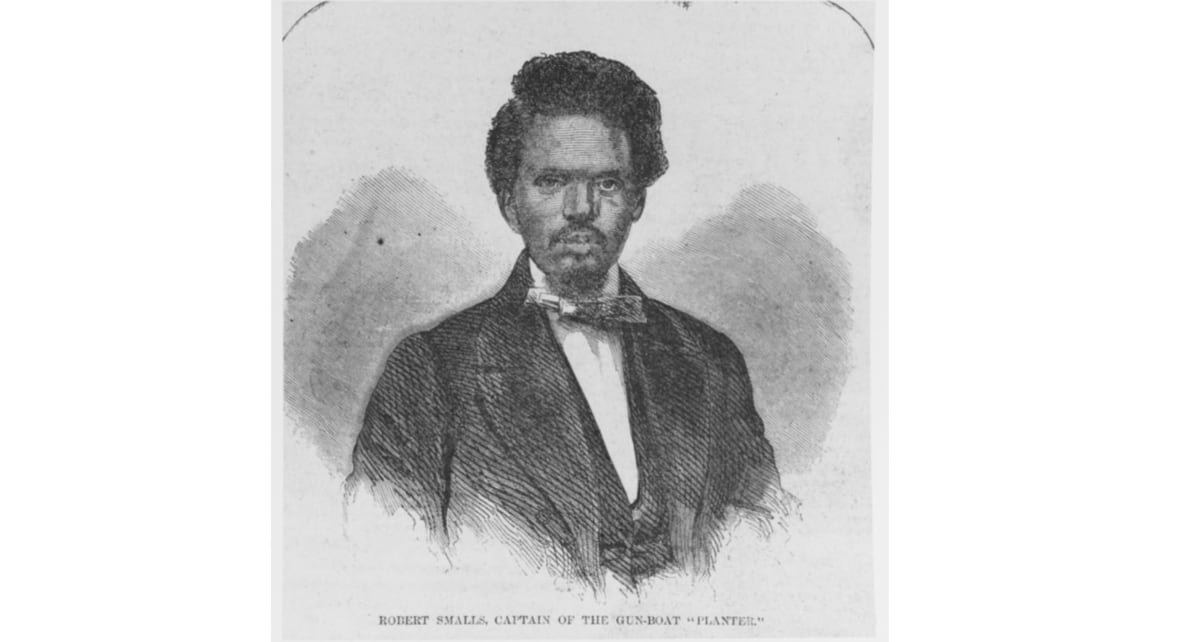
In the summer of 1861, about the same time the Rebels routed the Union army at Manassas Junction and just a few months after the firing on Fort Sumter and its surrender to South Carolina, Robert Smalls left his job at Simmons’ rigging company to work as a crewman on a wood-burning, steam-powered vessel, with paddle wheels port and starboard.
Originally built to transport cotton, it was named, appropriately enough, Planter.
At that point, the interests of the Confederacy and the crafty Mr. Smalls took a very interesting turn. Not surprisingly, the new Confederate government wanted to add another vessel to its Charleston fleet. They leased Planter, armed it with cannons and turned it into a vehicle to move troops and supplies to various military installations in and around Charleston Harbor.
But Planter needed a wheelman.
The Confederate officers in charge of the vessel, impressed by Smalls’ knowledge of the harbor, promoted him to the job.
“Wheelman”may not sound glamorous, but it was another name for “pilot” — a title not permitted Smalls because he was black.
Despite the title, Smalls realized that the new post offered him was a chance at freedom.
In the fall of 1861, the Union Navy had just attacked and seized the Port Royal area. Through the grapevine, he heard that the slaves in the vicinity were well treated by the Union forces, and while there was still no official policy regarding emancipation, one thing was certain: No slaves were being returned to their owners.
This rumor was confirmed as fact in a message he received from his mother. Though legally still a slave, she now was living the life of a free woman, earning money cooking for the Northern soldiers who had just occupied the master’s house.
The message was clear: If only Smalls and his family could reach Port Royal, they too could enjoy the protection of “Uncle Abe’s” troops.
The idea of escaping was raised first by one of Smalls’ black crew members who jokingly proposed that they take control of Planter and sail it straight to the Union fleet blockading Charleston Harbor.
Smalls immediately seized on the thought and let it be known that it was no joking matter: With careful planning, it could be done.
Except for the captain and the other two officers who were white, Planter’s remaining eight crew members were black, and of those only one was deemed untrustworthy.
A meeting was held at which the six crewmen pledged him their loyalty and said they would be ready to act whenever the plan was in place.
Wasting no time, Smalls devised a scheme, risky but possible. Occasionally the captain and the officers would spend the night in town, leaving Smalls in charge of Planter.
It was then that he decided the escape should begin — but not without factoring in several other key players. There was the untrustworthy black crewman, who would have to be sent on an errand. And Smalls’ family (a son was born in 1861), four other women and a child would have to be spirited onto a nearby ship and hidden by a slave sailor.
As Planter got underway, it would pick them and the sailor up, then head out to sea.
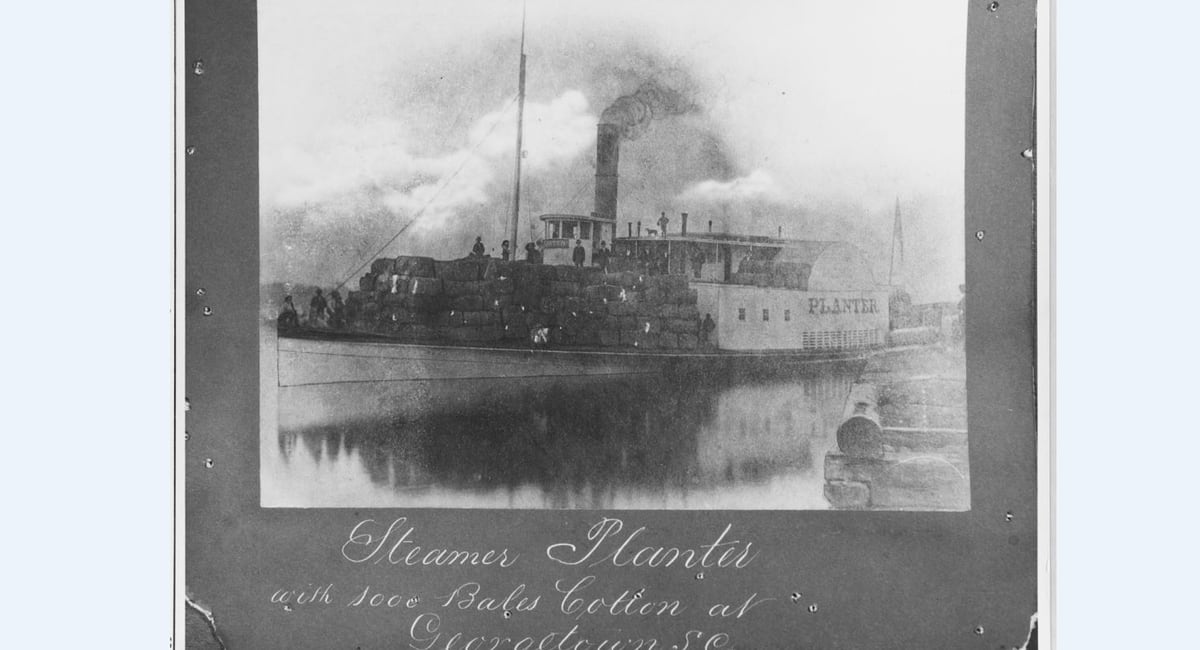
On May 12, the conspirators felt conditions were ripe to make their move. The three white officers departed to spend the night ashore. It was time to cast off.
But first Smalls and his crewman made an agreement not to be taken alive if capture appeared certain.
If they met with overwhelming resistance from the forts in the harbor, they would blow up Planter and go down with the ship.
At 3 a.m. Smalls hoisted both the Confederate and South Carolina flags, then signaled for the vessel to get underway.
It slowly left the wharf, stopped briefly at the nearby boat to pick up the women, children and the sailor who had hid them, then proceeded.
Five well-manned, heavily gunned coastal forts lay ahead of them, and just beyond loomed Fort Sumter, on a man-made island in the very center of the harbor.
Any one of the forts could blow Planter to bits.
Clad in the captain’s jacket with a huge straw hat pulled low on his forehead, Smalls — who was built like the captain, short and stocky — stood in the ship’s pilot house with the signal cord in his hand.
As Planter approached each of the forts, he pulled the steam whistle, giving the appropriate signal for safely passing the dangerous cannons of the bastions.
The ship then reached Fort Sumter.
Smalls pulled the cord, and the steam whistle bellowed forth two long blasts and one short.
Smalls waited tensely for the reply. Would it ever come? Perhaps someone at Sumter wanted to speak with a Planter officer or needed a lift to another installation?
At last the guard on duty shouted,“Pass the Planter.”
Coolly, arms folded just the way the captain often stood, Smalls nodded to his “officers”to get the ship underway.
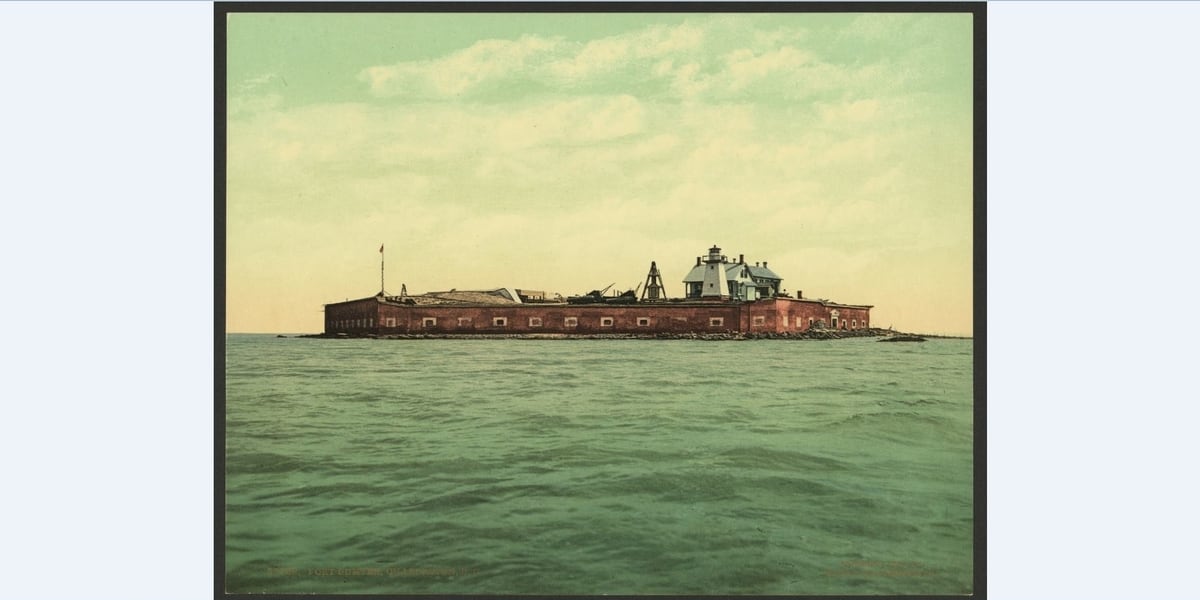
No sooner was the steamer out of range of Rebel guns than Planter’s crew lowered the Confederate and South Carolina flags and hoisted a piece of white cloth as a flag of surrender.
Picking up speed, Smalls headed straight for the Federal fleet, knowing the ship could easily fall victim to Yankee broadsides.
In the mists of early morning,there was no guarantee that the white flag would be seen.
The Union warship Onward was first to spot the approaching Planter.
“All hands to quarters!” shouted the lookout.
The Confederate vessel continued straight toward Onward. Guns turned directly on the threatening ship, and the command to fire was seconds away when a Union sailor spied the white flag.
Planter had made it.
Smalls tipped his hat to the Union captain and shouted: “Good morning, sir! I have brought you some of the old United States’ guns, sir!”
When Onward’s commander boarded their vessel, the escaped slaves’first request was to have the Stars and Stripes hoisted on Planter.
At that moment, one of the women lifted her child way above her head and told him to look at the flag, for it promised a new and brighter future.
Robert Smalls’ derring-do was not only a blow to the Rebels defending Charleston; it was also “quite an acquisition to the [Union] squadron,”said Adm. Samuel F. DuPont, commander of the blockading squadron.
If the ship weren’t bounty enough, Planter also carried a useful cargo: a gun carriage, four cannons and a large supply of ammunition — also a secret code book that would enable the Union Navy to decipher messages relayed by Rebel signal flags in the harbor.
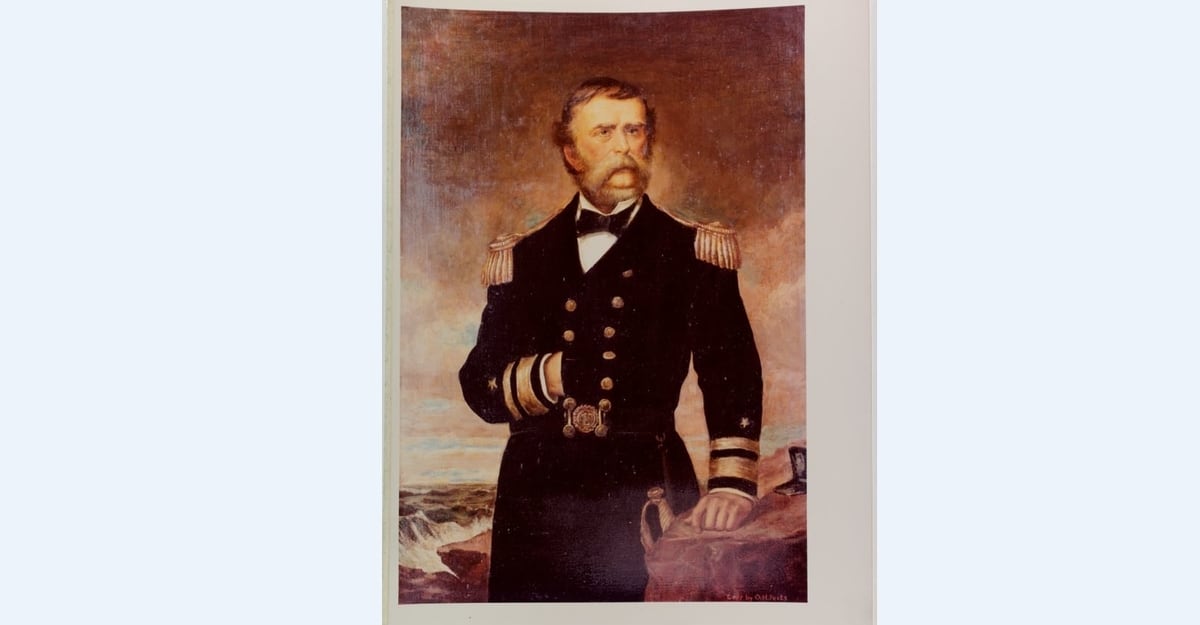
More than any of these acquisitions, though, the most valuable one proved to be Smalls’ broad knowledge of the harbor, rivers and inlets.
For more than a year he had navigated those waters for the Rebels, and he knew almost every fortification in the region.
According to Commodore DuPont, Smalls’ intelligence was “thorough and complete as to the whole defenses of Charleston.”
DuPont wasted no time acting on at least one piece of that intelligence.
Upon hearing from Smalls that the Rebels had pretty much abandoned the fortifications on the Stono Inlet, which protected the southwestern approach to Charleston, DuPont dispatched three gunboats and successfully secured the area.
It became, as Secretary of the Navy Gideon Welles pointed out in his annual message to Congress, “an important base for future military operations.”
He credited Robert Smalls with the information that made it possible.
Robert Smalls’ fame soon spread well beyond official circles.
He was a hero in the North. Congress passed a bill, signed by President Abraham Lincoln,that awarded a generous purse to Smalls and his crew.
The Union press editorialized on Smalls’ gallantry. The New York Times declared Smalls’ theft of Planter “one of the most heroic acts of the war.” Frank Leslie’s Weekly Illustrated Newspaper agreed, dubbing Smalls and his crew “Heroes in Ebony.”
Even in the Confederate South Smalls’ exploits were recognized, however grudgingly.
Emma H. Holmes of Camden, South Carolina, for example, wrote in her diary that the dash to freedom had been “most Disgraceful,” although she conceded that it was “one of the boldest and most daring things of the war.”
Those pressuring the Lincoln administration to free the slaves and enlist them into the Union Army saw Smalls’ intelligence and bravery as further confirmation of their cause.
Who could now question the capabilities of a black man?
“Is he not a man — and is he not fit for freedom, since he made such a hazardous dash to gain it?” posed the New York Daily Tribune. “Is he not a man and a hero — whose pluck has not been questioned by even the Charleston Courier or The New York Herald?…What white man has made a bolder dash or won a richer prize in the teeth of such perils during the war?”
Not only his heroics but his handsome appearance could help make that case, contended these advocates.
Sturdily built, with a dark complexion, thick hair, goatee and piercing eyes, Robert Smalls stood 5 feet 5 inches tall, and what he lacked in height he made up in personality.
Good-humored,intelligent,well-spoken and self-confident, who better could represent the African-American cause than the man who stole Planter from right under the Rebels’ very eyes?
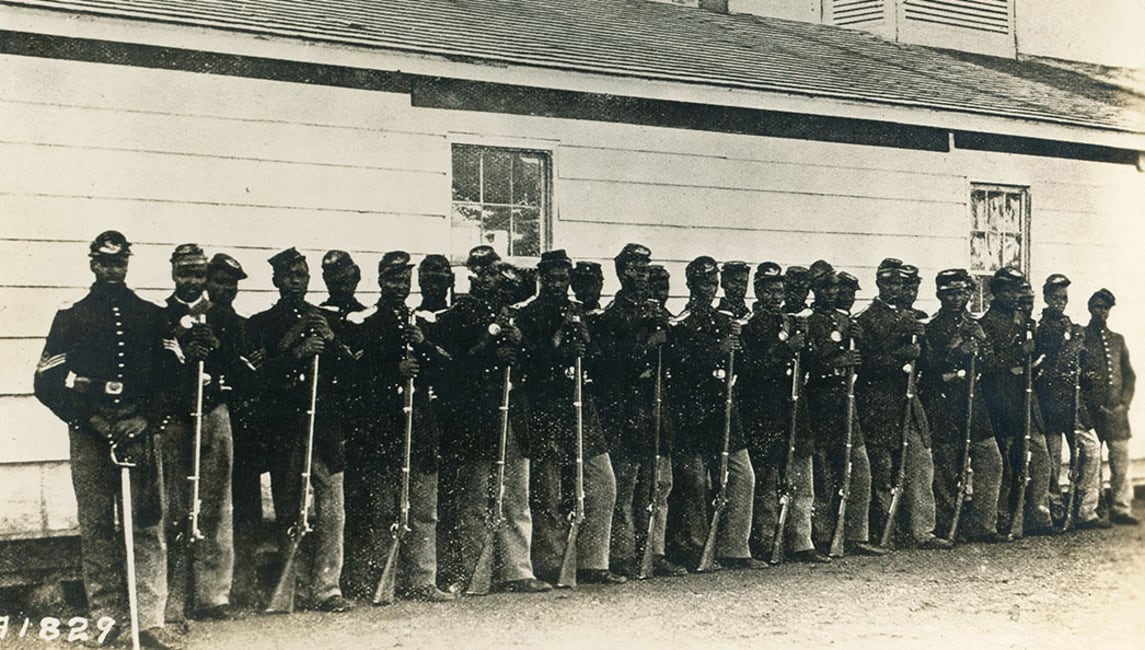
Urged by the commanding officer at Port Royal, Maj.Gen.David Hunter, Smalls went to Washington escorted by a military chaplain, Mansfield French.
His mission :to persuade Lincoln and Secretary of War Edwin M. Stanton to permit the enrollment of blacks in the Union Army.
After several interviews, Smalls got what he came for — an order drafted by Stanton that Smalls personally delivered to Gen. David Hunter in South Carolina.
It authorized him to muster 5,000 African Americans at Port Royal into the service of the U.S. Army.
Significantly, Hunter’s decree was perhaps the first official sanctioning of black troops in the U.S. Army since they had served the American cause in the Revolutionary War.
The unit was organized as the 1st South Carolina Volunteers, and Smalls was eager to enlist.
“How can I expect to keep my freedom if I’m not willing to pay for it?” he asked.
The general in charge of recruiting, however, recognized Smalls’ greater value to the U.S. government.
He refused Smalls’ request to join, insisting that he could better serve the Union as a civilian pilot for Union warships and Army transport boats.
Smalls accepted the advice, and over the next two years, employed as a civilian by the Union government, he played a critical tactical role in no fewer than 17 naval battles.
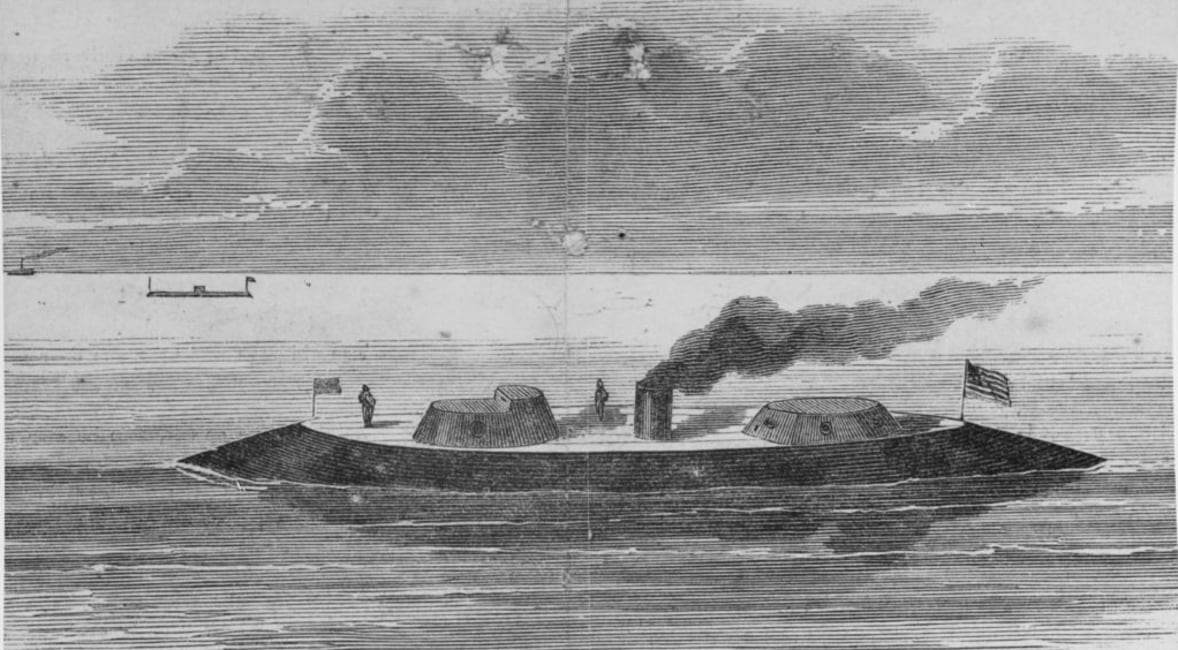
Most of his missions were routine — ferrying rations, munitions and men to various Union-held inlets and islands in the Charleston area.
Two 1863 battles,however, gravely tested Smalls’ mettle.
In early April of that year, when the Union Navy launched a massive attack on Charleston, Smalls was piloting Keokuk, one of the armada’s ironclads.
Those armor-plated vessels rode low in the water, designed that way to make them difficult targets. If they were hit, then the thick, rounded ,iron armor made them all but indestructible: Shots would bounce off instead of penetrating.
At least that’s what the Navy designers thought.
As it turned out ,the new ironclads were no match for the heavily armed Confederate forts in Charleston Harbor.
In a battle that lasted 100 minutes, the guns of the ironclads delivered only 139 rounds to the 2,000 shots hurled from the forts. The Union ships were hit no fewer than 439 times.
Keokuk took the worst of it and was struck more than 90 times by Confederate artillery. Smalls was barely able to steer Keokuk out of the harbor.
It sank the next day, moments after its crew was rescued.
Soon reunited with Planter, which had been converted to an army supply and transport ship under the command of a Capt. Nickerson, Smalls assumed his pilot duties and resumed more ordinary missions.
But that routine was shattered on Dec. 1, 1863, when Planter came under intense fire from Confederate artillery.
Nickerson, convinced that there was no way out, ordered Smalls to surrender the ship.
Smalls refused, arguing that while the Rebels would treat the captain, a white man, with respect, the rest of the crew — runaway slaves — would likely suffer a fate worse than death.
Panic-stricken, the captain rushed below to hide.
Smalls took command and, despite continuous shelling, steered his famous vessel out of the range of the Confederate guns.
For that valiant act,he was promoted to captain — the first black man to command a ship in the service of the United States.
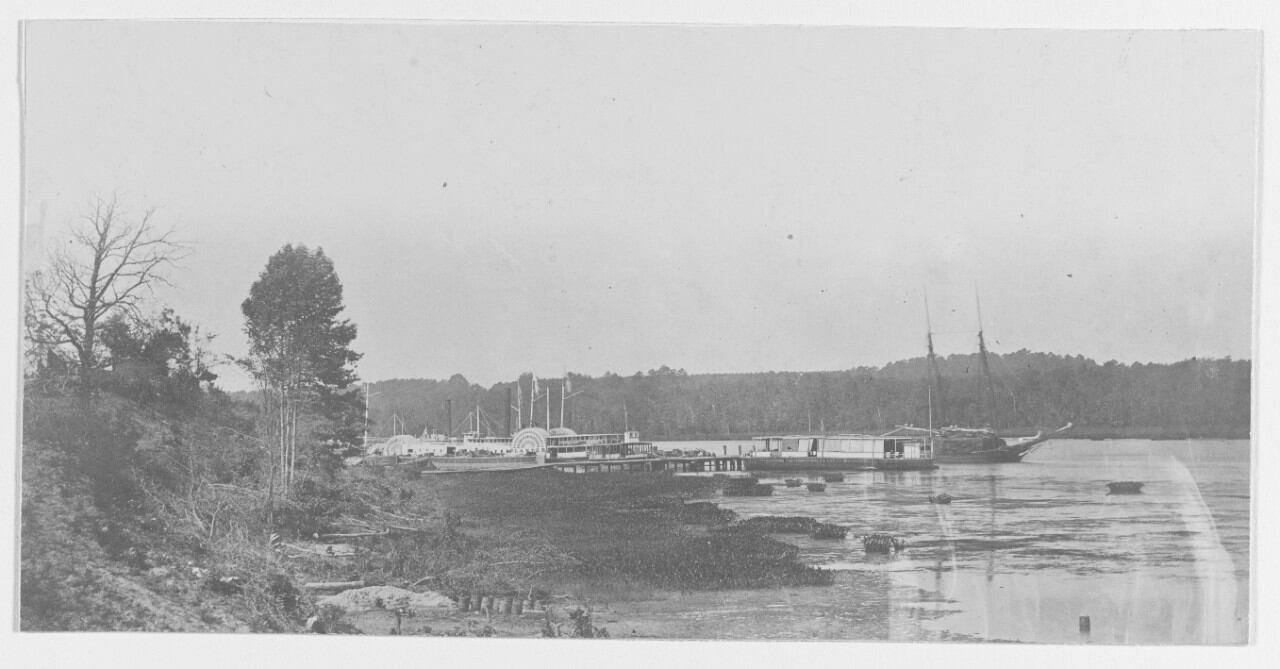
In the immediate postwar era Smalls enjoyed even more recognition and a host of opportunities.
The best known African-American in the state of South Carolina, if not the whole nation, he was honored by both Southerners and Northerners.
A widely-circulated story at the time tells of two black South Carolinians arguing about Smalls’ greatness.
One declared Smalls great but allowed that Jesus Christ was greater.
True, the other conceded, but “Smalls is young yet.”
And he still wasn’t ready to hang up his hat. Over the next few years, Reconstruction laws granted all men, white and black, the right to vote and hold office, and Smalls decided to test the political waters.
His only obstacle: his inability to read and write.
He overcame that hurdle with the help of private tutors, and in 1868 he was elected as a Republican to the South Carolina House of Representatives.
Two years later he moved on to the State Senate while also serving in the South Carolina State Militia and rising to the rank of major general.
In 1875 he sought a seat in the U.S. House of Representatives, won that race, and was returned for four more terms.
Smalls would hold a seat in Congress longer than any other African-American until the 1950s, and he went on to another 20-year career as U.S. collector of customs in Beaufort, South Carolina.
Perhaps most significantly, Smalls purchased his former master’s house in Beaufort. His life had really come full circle.
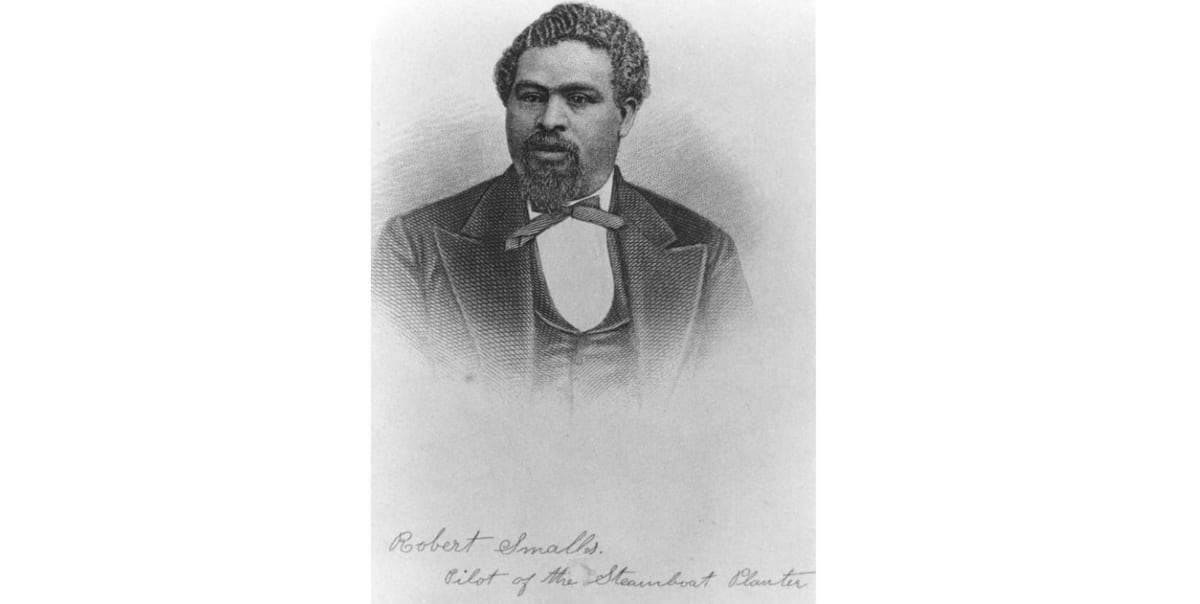
And yet, for all the military and political battles Robert Smalls won, one loss would haunt him for the rest of his life.
In 1895, despite his best efforts at the South Carolina Constitutional Convention, he and several of his colleagues failed to block the “Jim Crow” legislation that disenfranchised most of South Carolina’s black men.
Perhaps his best-remembered words come from that losing battle: “My race needs no special defense,for the past history of them in this country proves them to be the equal of any people anywhere. All they need is an equal chance in the battle of life.”
It would be another seven decades — marked by the murderous terrorism of the Ku Klux Klan and the South Carolina Red Shirts, organizations committed to denying blacks suffrage — before those voting rights would be restored.
Even then, it would take a new “civil war” — in America’s streets, schools, churches, halls of Congress and Oval Office— before African Americans would regain that equal chance Robert Smalls fought so hard to win.
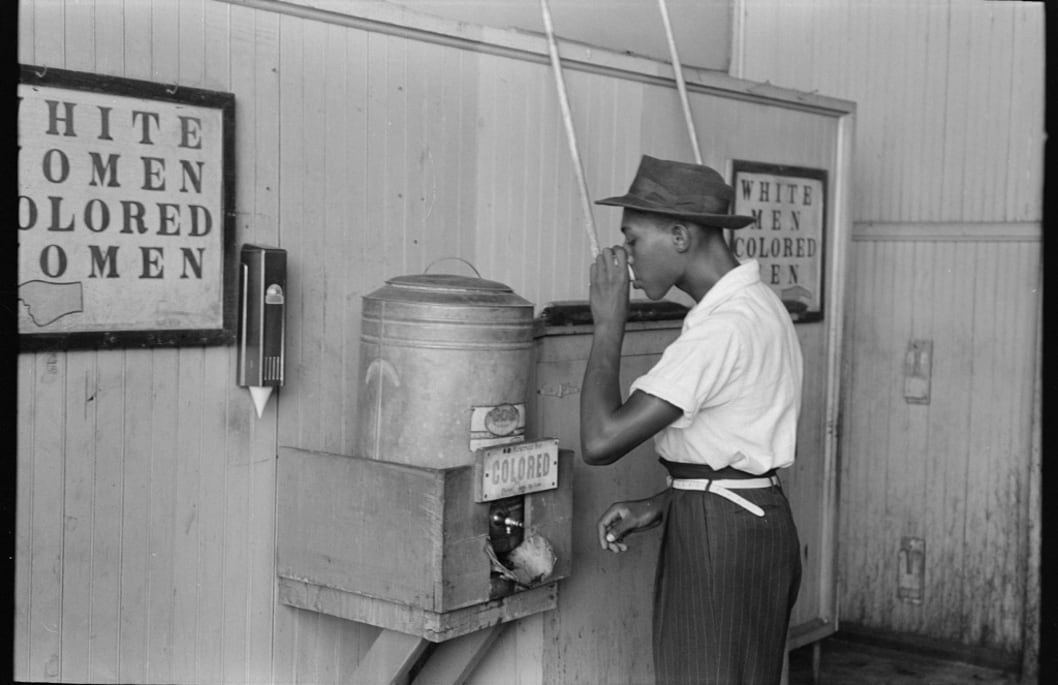
Gerald S. Henig is professor emeritus of history at California State University, East Bay. He is the author of Henry Winter Davis: Antebellum and Civil War Congressman From Maryland and co-author of Civil War Firsts: The Legacies of America’s Bloodiest Conflict. This article was first published in the March 2007 issue of America’s Civil War, one of Navy Times’ sister publications. To subscribe, click here.
